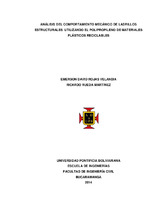| dc.contributor.advisor | Director. Torrado Gómez, Luz Marina | |
| dc.contributor.author | Rojas Velandia, Emerson David | |
| dc.contributor.author | Rueda Martínez, Ricardo | |
| dc.coverage.temporal | 2014 | spa |
| dc.date.accessioned | 2022-10-18T21:14:24Z | |
| dc.date.available | 2022-10-18T21:14:24Z | |
| dc.date.issued | 2014-09 | |
| dc.identifier.uri | http://hdl.handle.net/20.500.11912/10292 | |
| dc.description | 107p.: (pdf); il; imágenes; gráficas; tablas. | spa |
| dc.description.abstract | Con este trabajo se logró analizar el comportamiento de ladrillos estructurales adicionando un nuevo material (polipropileno reciclado) para su fabricación, tratando de obtener una resistencia a la compresión de 3000 psi. Con la caracterización de los materiales tradicionales (Agua, cemento, agregado fino y agregado grueso) además con el nuevo material introducido en la mezcla para reemplazar un porcentaje del agregado (polipropileno reciclado) se procedió a fabricar cilindros (altura 20 cm x diámetro 10 cm) con la mezcla alternativa, la cual variaba sus cantidades del nuevo material 10%, 20% y 30% realizando los respectivos ensayos a la compresión de 7 y 28 días. Los resultados arrojaron que la mezcla con 10% alcanzo la resistencia propuesta, con estos valores se elaboran los ladrillos (24.5 cm x 14.5 cm x 7 cm) teniendo en cuenta los límites que presenta la Norma Técnica Colombiana NTC 4026 y comparando los resultados con ladrillos convencionales se concluye que los ladrillos con el nuevo material son óptimos para la construcción y adicional a esto se observa la disminución de peso en cada espécimen ocasionando un beneficio en las estructuras ya que podrán ser ligeras y la cantidad de refuerzo disminuye, otro beneficio de mayor importancia es la reutilización de estos desechos reciclables que día a día contaminan el planeta. | spa |
| dc.description.abstract | This work was possible to analyze the behavior of structural bricks adding a new material (recycled polypropylene) for manufacturing, trying to obtain a compressive strength of 3000 psi. The characterization of traditional materials (water, cement, fine aggregate and coarse aggregate) in addition to the new material introduced into the mix to replace a proportion of the aggregate (recycled polypropylene) proceeded to manufacture cylinders (height 20 cm x diameter 10 cm ) with the alternative blend, which varied the amount of new material 10%, 20% and 30% respective performing compression tests 7 and 28 days. The results showed that the mixture reached 10% resistance proposed, these values bricks (24.5 cm x 14.5 cm x 7 cm) are made taking into account the limitations presented by the Colombian Technical Standard NTC 4026 and comparing the results with bricks conventional bricks is concluded that the new material is optimal for the construction and in addition to this the reduction of weight in each specimen was observed causing a benefit because the structures can be light and the amount of reinforcement decreases, another benefit of greater importance is the reuse of these recyclable wastes daily pollute the planet. | en |
| dc.format.mimetype | application/pdf | spa |
| dc.language.iso | spa | spa |
| dc.publisher | Universidad Pontificia Bolivariana | spa |
| dc.rights | Attribution-NonCommercial-NoDerivatives 4.0 Internacional | * |
| dc.rights.uri | http://creativecommons.org/licenses/by-nc-nd/4.0/ | * |
| dc.subject | Tesis y disertaciones académicas | spa |
| dc.subject | Ladrillos | spa |
| dc.subject | Plásticos en la construcción | spa |
| dc.subject | Resistencia de materiales | spa |
| dc.subject | Normas Técnicas - 4026 | spa |
| dc.title | Análisis del comportamiento mecánico de ladrillos estructurales utilizando el polipropileno de materiales plásticos reciclable | spa |
| dc.type | Trabajo de grado | spa |
| dc.publisher.department | Escuela de Ingenierías | spa |
| dc.publisher.program | Ingeniería Civil | spa |
| dc.type.hasVersion | publishedVersion | spa |
| dc.description.sectional | Bucaramanga | spa |
| dc.description.degreename | Ingeniero Civil | spa |


